Running a profitable manufacturing operation in Mexico, or anywhere for that matter, is a challenging proposition. That is why people in industry love stable currencies.
Whether it´s yen, yuans, dinars or Mexican pesos, it´s enough of a task to make a profit dealing with factors within one´s control. Introducing factors outside of a manufacturing executive’s control, such as fluctuations in currency exchange, are the last issues anyone wants to tackle.
But that doesn´t change the fact that currencies fluctuate and the Mexican peso is among them.
The good news for people in the Mexico manufacturing realm is that the two principal currencies with which they deal, dollars and pesos, have changed little and generally have moved together, even as the Euro and other currencies have jumped around.
One never knows, however, how long this stability -- an accountant´s dream -- will last. That´s why it´s important to know about Mexican peso futures.
It is possible to purchase pesos, like pork bellies, wheat and jet fuel, for periods of up to 18 months from now. For that "option" to buy, a party must pay a premium up-front. That premium can come in the form of a set fee or a percentage of the deal´s value. In purchasing an option, the party is buying the right to buy a particular commodity at a set price. For example, Southwest Airlines, sensing fuel prices were going to rise two years ago, "locked in" millions of gallons of fuel at what turned out to be an inexpensive price and, in so doing, was far more profitable than competitors.
"Locking in" the price of a commodity, however, does not mean that one is obligated to purchase. It means, merely, that one has the right to purchase at a designated price. If a manufacturing company in Mexico seeking to safeguard profits, decides to purchase the option to buy Mexican pesos at a certain rate to the dollar, the company may still purchase U.S. dollars at a cheaper rate on the open market should they be available. Some 20 major currencies, including the peso, are traded regularly in world markets.
On to the Mexican peso:
On a recent day, the peso was trading at 7.5525 US cents, which is to say, 13.24 to the dollar. On the same day, the currency futures market listed pesos for purchase 18 months from now (October, 2013) at 7.2625 cents, or 13.76 to the dollar. In essence, the markets were speculating that the peso will be worth 29/100ths of a penny less in 18 months.
What a company pays to purchase an peso option at that projected price depends on its relationship with brokerage houses, or its bank, but is generally expected to hover around one percent. If a manufacturer in Mexico wants to lock in the price of buying pesos then, it would pick up the phone, call a broker and, for an estimated $10,000, it would control the terms of a potential $1 million transaction. (If the rate turns out to be less the company, obviously, would not want to exercise such option.)
While discussions about peso volatility in 2012 sound like mindless pontificating, the topic was, at one time, a much more serious and volatile issue. Today, the peso is one of the world´s most stable currencies. But it should take only the syllables in the name George Soros to remind the public about how volatile currencies can be. Soros, the Hungarian-American businessman, has made billions of dollars speculating in foreign currencies that he bet were over- or under-valued.
Moreover, those with a longer memory will recall wild daily fluctuations in the peso during the 1980´s and 1990´s. In fact, on November 21, 1985, in an emergency action, the Chicago Mercantile Exchange suspended trading of the Mexican peso futures contract because of an announcement by Bank of Mexico that it was imposing foreign exchange limitations.
One large trader of currencies is CME Group, which offers beginners a series of tutorials on line. One of CME Group´s select plans allow its clients to trade at preferential rates by paying for a $2,000 membership. Mexican peso information may be found on the company's website, as well. For retail traders, the best place to start is to set up an account with a broker, said Fleur Howard, a company spokeswoman.
Subscribe
Sign up and stay informed with tips, updates, and best practices for manufacturing in Mexico.





